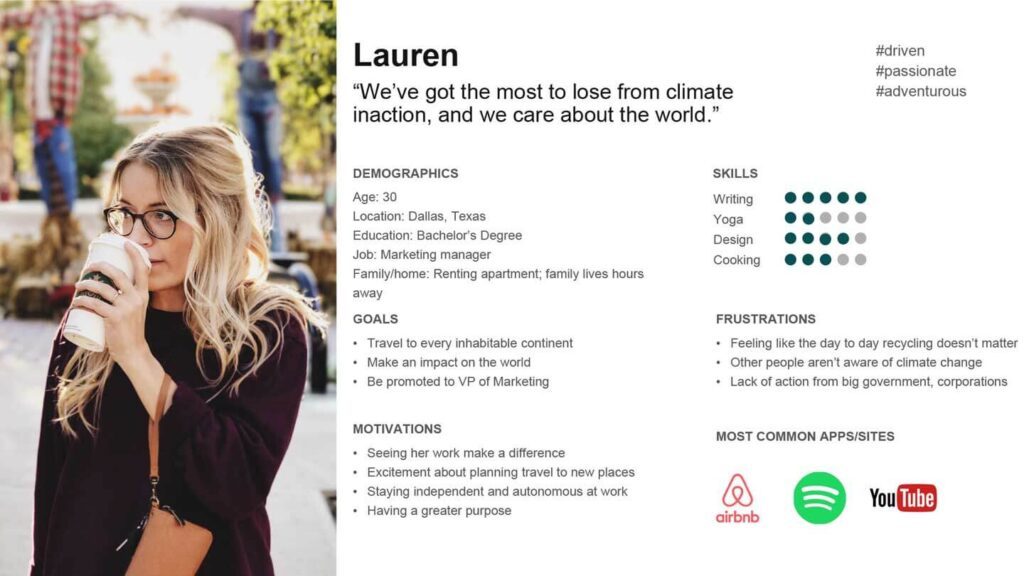Learning how to use personas is key to effective UX design
The user persona is a tool created by user experience designers to create empathy with the design team and stakeholders with the target user group. It’s a powerful design deliverable that connects the data from all of the research that’s been analyzed with the emotions of the people who are designing solutions.
And what’s really beautiful about the user persona is that it’s like a living document that the design team continues to refer back to throughout the life of a project.
That sounds really complex and complicated, so let’s break it down into it parts.
What is a user persona?
Think of it like a business card. A user persona is a snapshot representation of a group of humans.
As designers, we need to know who we’re designing for, and the persona helps us visualize and connect with them. When I say visual — I mean it too.
You can create your persona using the tools you’re comfortable with. I’ve created personas in Photoshop and Figma. I’ve even created one in PowerPoint. It’s up to you how you want to capture that.

Notice how this persona example includes:
- A name and a face
These elements are fictional, and they are the only “made up” parts of the persona. By giving the persona a name and a face, it taps into our brains and helps us feel empathy. - Demographic information
This is where we get factual. We need to know details about the persona. How old are they? What do they do for a living? What are hobbies? We learn as much as we can about the target user group we’re designing for to add these details. - Pains and Gains
Even more than demographics, we need to understand the underlying motivations and frustrations of our user persona. Again — based in fact — we add these details to give us the full picture of what this persona is like. It helps us tap into our emotions so we can connect with them.
Why do we create personas?
The answer is human-based design.
Instead of designing a software, product or service based on the preferences of the design team, personas step in to represent the people we’re designing for. They serve as the voice of the user. It helps us step out of ourselves and connect with them.
And we keep coming back to them. The persona will live on throughout the project to help the team remember who we’re designing for.
When should we create personas?
We create user personas AFTER our initial research and BEFORE we start ideating solutions.
Here’s why: user personas may have a fictional name and photo, but everything else about them is based on fact.
We look at all of our research — our interviews, surveys and so forth — and then we put it all together to get a really good picture of our persona’s needs, goals, motivations, and frustrations.
Once we have that picture, we can start coming up with ideas to solve their pains and frustrations.
How do we create a persona?
There is no right or wrong way to create a persona, but there are definitely methods that will help you develop a persona that works best for your needs. You’ll want to follow these steps:
Step 1 – Gather the data
It’s important to learn as much as you can about the target user group to create this persona.
- Interviews with users will help you understand basic information as well as motivations and frustrations.
- Then you analyze what you’ve collected. Take all of the information you gathered and look for patterns and common themes. An affinity diagram is a great way to do this.
Step 2 – Describe the persona
The purpose here is to develop empathy and understanding for this persona’s needs.
- Give the persona name and a face
- Include demographic details — including job, age, lifestyle, and interests
- Show goals, motivations, needs and frustrations
- Include a quote or a description.
After I create a persona, I like to keep it nearby. If a question comes up, I ask “What would be best for (the name of my persona)?”

In the case of the above persona, I was working on a project to understand how millennials felt about climate change and how I would design a solution to address their concerns.
I interviewed six people in the target age range and gathered information about their thoughts and feelings regarding climate change. I analyzed the data by creating an affinity diagram, which I created from the information the users provided in their interviews.

Ultimately, in creating this persona, it led me through the ideation phase and eventually to designing a mobile game. Through each step of the process, I imagined how “Lauren” would play the game.
Read the full case study here.
Key takeaways
Personas are a strong tool for designers to connect to the users they are designing solutions for. They are based in fact and created from the data gathered during research.
They should not remain locked in a cabinet after they are created. Personas are a living document to be shared among the design team and stakeholders and should help guide design decisions throughout a project.
Personas are powerful. Done well, they can be used as the basis of solution development, marketing campaigns, and more.











